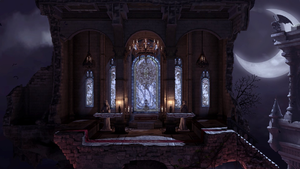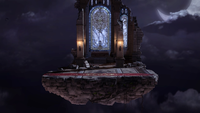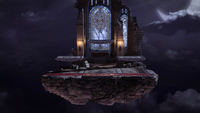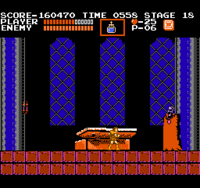Dracula's Castle
| Castlevania Dracula's Castle | |
|---|---|
  Dracula's Castle in Super Smash Bros. Ultimate. | |
| Universe | Castlevania |
| Appears in | Ultimate |
| Availability | Starter |
| Crate type | Normal |
| “ | On this stage, various characters from throughout the series will appear as guests and you can get items by breaking the candles. Including new and classic tunes, this stage has 34 total tracks to listen to! | ” |
| —Super Smash Blog, Super Smash Bros. Ultimate Official Site | ||
Dracula's Castle (ドラキュラ城, Dracula Castle), also known as Castlevania, is a stage in Super Smash Bros. Ultimate. It is the home stage of Simon and Richter. They're both fought here in their unlock battles.
Stage overview[edit]
Dracula's Castle features two platforms to the left and right that move up and down. All the way to the right side is a set of stairs whose bottom half is broken off. Candles in the background can be destroyed, dropping items; if items are turned off, these candles will not spawn. Each end of the stage is surrounded by the darkness. Dracula's coffin appears in the background. Star KO's cannot happen on this stage due to the background wall obscuring their would-be victim.
When hazards are turned off, the two platforms do not move and the candles never appear.
Dracula's Castle is also the only stage to feature a darker lighting filter.
Background characters[edit]
During gameplay, various enemies from the Castlevania series will make an appearance, including the Creature (also known as "Frankenstein's Monster", from Frankenstein by Mary Shelley) with his Flea Man ally Igor, a Mummy, Medusa Head, the Werewolf, Carmilla (in her giant mask form, also called "Vampira", from Simon's Quest), and Death. Each enemy has their own entrance based on how they appeared during their original boss battle (such as the Werewolf leaping through a window). The silhouette of Kid Dracula from the Kid Dracula spin-off series appears occasionally. All these characters stay in the background, which means they do not interrupt the fight at all, even with stage hazards turned on.
When the moon disappears in the darkness and bats gather around Dracula's coffin, lightning will flash, revealing the shadows of Dracula or Kid Dracula in the middle of a castle. Dracula himself appears as a boss in Adventure Mode: World of Light and Classic Mode in a boss arena resembling the castle, but with a flat and empty layout.
Ω form and Battlefield form[edit]
The Ω form and Battlefield form is set on a completely flat version of the normal form's main platform that is also resized and reshaped to match Final Destination and Battlefield, respectively. The stairs and candles are absent, and on the Battlefield form there are also three soft platforms that remain in place.
Hazards Off[edit]
When hazards are turned off, the candles do not appear and the moving platforms do not move.
Tournament Legality[edit]
Dracula’s Castle has been consistently banned from tournaments due to its unusual geography including two short walls in the center which create a gap, the slope on the right side of the stage along with fairly small blast zones that can result in earlier than usual KOs.
Origin[edit]
Throughout the Castlevania series, the top of Dracula's Castle is the endpoint of the protagonist's journey, where they fight the series' main antagonist, Dracula. The castle is always a large structure full of horrifying monsters and tortuous rooms. In the background is the clock tower, a recurring area in the series. Candles are a common element as well and are broken to reveal whip upgrades, hearts, food, and items. Every time the castle is destroyed, it magically rebuilds itself every hundred or so years, along with a reincarnation of Dracula.
This final area usually has the same structure throughout the Castlevania series - a long stairway leading to a short hallway, finally ending with Dracula's quarters. The Smash stage condenses this, making the staircase lead directly to Dracula's room. The broken staircase may be a reference to Symphony of the Night, where the staircase is broken into two pieces.
Gallery[edit]
Names in other languages[edit]
Trivia[edit]
- Dracula's Castle is the only new third party stage to appear in Ultimate's base game.
- Out of all the new stages, this is the most common stage in Classic Mode, and is fought on for more rounds than Great Plateau Tower.
- When playing as Pokémon Trainer, player 1 and 2 will stand in front of the left and right statues, respectively. Player 3 and 4 will stand in front of stained-glass windows on the left and right side, respectively.
- Dracula's Castle is the only new stage in the base game to not be based off a 2010s game.
- The Moon cannot be summoned from an Assist Trophy on this stage, due to the normal moon being visible in the background, and Nikki cannot be summoned due to the dark background obscuring her drawings. Additionally, Lunala cannot be summoned from a Poké Ball here.
- Dracula's Castle possesses a unique camera effect that gives the edges of the screen a dark fade, which is visible even when taking screenshots.
- Masahiro Sakurai stated in a YouTube video[1] that Dracula's Castle particularly dark aesthetic was useful during development, examples including seeing a block anywhere on-screen as well as being used for an edition of "Find the Enderman," a game Sakurai created where he would hide the Enderman somewhere on screen for the development team to find.
References[edit]
External Link[edit]
- Article on the Castlevania Wiki.
|
| |
|---|---|
| Fighters | Simon (SSBU) · Richter (SSBU) |
| Assist Trophy | Alucard |
| Boss | Dracula |
| Stage | Dracula's Castle |
| Item | Death's Scythe |
| Other | Dracula's Castle |
| Spirits | Spirits |
| Music | Ultimate |





